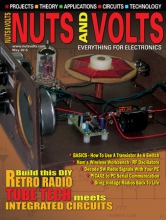Nuts and Volts Magazine
Features
This time, we’ll focus on interacting with the bare-metal microcontroller by handling both digital and analog inputs.
The NPN transistor switch can easily solve many design problems.
It’s fun and easy to bring vintage radios back to life! Follow along as a 1937 DeWald radio is restored.
A computer, some powerful software, and a shortwave receiver combine to make decoding many types of radio transmissions possible.
Projects
This back-to-the-future one-tube radio is made with readily available parts, operates on 12 volts, and offers amazing performance.
Columns
Q&A
by Tim Brown
Reader Questions Answered Here (05.2015)
A question on op-amp accuracy, getting certified, and some tips on batteries.
PICAXE Primer
by Ron Hackett
PICAXE-PC Serial Communication — Part 1
We’ll continue our experiments with the Prolific cable, but this time focus on sending data back and forth between a PICAXE processor and a PC.
The Ham’s Wireless Workbench
by H. Ward Silver
RF Oscillators
Move up in frequency to the oscillators which make the signals that drive the ham’s wireless world.
Open Communication
by Louis E. Frenzel
Serial I/O Data Interfaces: Part 2
Get familiar with the high speed gigabit serial interfaces that dominate I/O today since we all use at least one of these regularly.
The Design Cycle
by Fred Eady
Wi-Fi on the Big Wire
Classic embedded Wi-Fi web servers based on microcontrollers have met their match. The ACKme Numbat stuffs an ARM microprocessor, Wi-Fi radio, TCP/IP stack, UART, real time clock, multiple GPIO pins, analog-to-digital converters, PWM generators, SPI portals, 1 MB of serial Flash, and an I2C interface into a 0.8” x 0.6” x 0.11” SMT package. All you need is a PC serial port and a terminal emulator to gain access to the Numbat’s rich set of resources.

